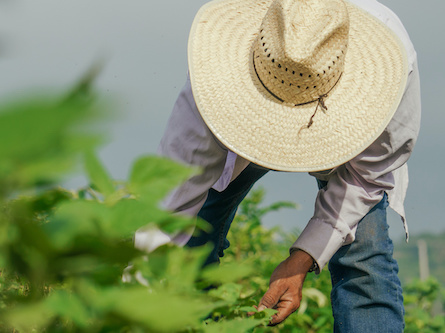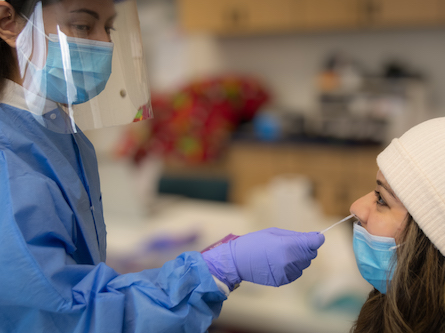By Ed Kissam
Structural factors affecting farmworker and low-income San Joaquin Valley immigrants’ vulnerability
- Crowded housing - more than 2X more crowded than average US households. Higher transmission of Delta, and now Omicron increase vulnerability.
- Workplace/travel to-from work--especially with uneven compliance with masking recommendations--increases vulnerability.
- Lags in securing boosters? Since FW’s and some other essential workers were priority 2B in initial rounds of vaccination, many are now due for boosters but may not have gotten them. (See ORALE analysis breakthrough vaccinations X time since vaccination.)
- Misplaced trust in natural immunity? Farmworker communities have had higher-than-average cumulative incidence of COVID-19 so it’s possible many who have been ill and recovered mistakenly feel they’re safe: likely not to be the case with Delta, still less with Omicron--though it’s not yet clear how virulent this newest variant is.
Farmworker health profile: many are “high-risk” for serious illness if infected with COVID-19
- 11% have diabetes, 15% have high blood pressure, 2% have cardiovascular disease. There is overlap among conditions, but 1 out of 5 have one of these high-risk conditions (CA NAWS FY17-18,analysis, courtesy of Rick Mines.)
- High BMI (body-mass index) and age are also risk factors. European Union considers those who are 50+ to be high-risk (about 1 out of 3 CA farmworkers.)
- Other less common “high risk” factors (CDC 10-14-21): pregnancy, chronic kidney disease, chronic liver disease, moderate-to-severe asthma…and other still less common conditions (e.g. HIV or other immunosuppression.)
- Overall, it is likely that more than half of all farmworkers (and probably similar proportions of other low-income Latino immigrants and family members served by ORALE COVID-19) are “high risk”.
There is effective medical treatment for high-risk patients but treatment needs to be immediate
- Monoclonal antibody or anti-viral treatment is highly effective - but needs to begin while case is still mild (<5 days after symptoms appear). Earlier treatment seems to help.
- Assume ORALE COVID-19 clients have needed to wait 2-3 days before getting tested. If “high risk”, they should have access to treatment within 1-2 days after test results.
- Monoclonal antibodies are already FDA-approved--preferably administered via infusion, but injection authorized: Bamlanivimab plus etesevimab, Casirivimab plus imdevimab, Sotrovimab
- Anti-virals in pill form have been shown to be highly effective, are easier, will soon be authorized.
- Molnupiravir (Merck) yielded 30% reduction in RR of hospitalization or death in the high-risk population. Approved by the FDA Advisory Committee on November 30th.
- Paxlovid (Pfizer) showed a 89% reduction in RR of hospitalization or death in clinical trials in the high-risk population, so a EUA was requested on November 16th.
What can ÓRALE COVID-19 do?
- Pilot and catalyze collaborative efforts to help FW’s-- and others without frequent access to health care-- assess whether they are ”high risk” for serious COVID-19 illness. (About 2 out of 5 farmworkers have not seen a U.S. health care provider).
- Initiate immediate efforts to develop memoranda of agreement with FQHC’s and local hospitals for immediate referral of unvaccinated high-risk clients who test positive to secure appropriate treatment. Both anti-virals should be approved by January, 2022.
- Counsel patients who test positive to be vigilant in identifying and getting high-risk family members in their HH tested as soon as possible with rapid-turnaround test and referred for immediate treatment if positive.
- If/when supplies of anti-virals permit, advocate for expansion to prophylactic use for FW family members living in crowded HH’s and prepare to facilitate availability.
- Increase messaging about the need for vaccination even for those who have previously been infected, build awareness of increased infectiousness of Delta and Omicron, build awareness of risk of hospitalization/death for high-risk individuals (including children), explain unknown risks of “long COVID”--including inability to work for even transitory cases.
Selected References
CDC on “high risk” conditions” (10-14-21) https://www.cdc.gov/coronavirus/2019-ncov/need-extra-precautions/people-with-medical-conditions.html
NIH COVID-19 Guidelines: Anti-SARS-CoV-2 Monoclonal Antibodies(10-19-21) https://www.covid19treatmentguidelines.nih.gov/therapies/anti-sars-cov-2-antibody-products/anti-sars-cov-2-monoclonal-antibodies/
Merck press release (11-30-21) https://www.merck.com/news/merck-and-ridgeback-statement-on-positive-fda-advisory-committee-vote-for-investigational-oral-antiviral-molnupiravir-for-treatment-of-mild-to-moderate-covid-19-in-high-risk-adults/
Pfizer press release (11-16-21) https://www.pfizer.com/news/press-release/press-release-detail/pfizer-seeks-emergency-use-authorization-novel-covid-19
Ken Carlson, “Stanislaus County wants to boost access for COVID-19 treatment that could save lives”, Modesto Bee, October 11, 2021
“UCSF Fresno COVID-19 Equity Project Is First in Area to Provide Free, Accessible and Early Treatment for Mild to Moderate COVID-19”, October 28, 2021 https://www.fresno.ucsf.edu/2021/10/28/cepfree/
National Agricultural Worker Survey health data (analyzed by Rick Mines) https://www.dol.gov/agencies/eta/national-agricultural-workers-survey/data

Ed Kissam is a retired researcher and evaluation expert whose work has focused on immigrant settlement and adult learning. He is currently a trustee of the WKF Fund, a small charitable-giving organization, and member of the National Center for Farmworker Health Advisory Committee to the CDC, an initiative focused on fighting COVID-19 in agricultural communities across the U.S.



